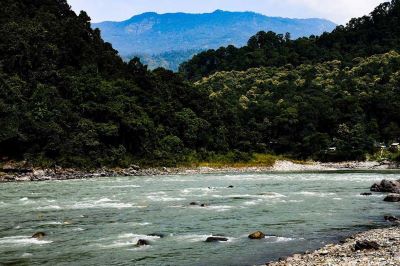Context-
The Teesta water dispute between India and Bangladesh poses significant challenges to both nations, impacting agricultural productivity, bilateral relations, and geopolitical dynamics in the region. The involvement of China further complicates the issue, adding a geopolitical dimension to an already complex situation. This analysis looks into the various dimensions of the Teesta conundrum, examining the historical context, economic implications, and geopolitical ramifications for India, Bangladesh, and China.
|
India–Bangladesh water Conflict
|
Historical Background and Economic Significance
The Teesta River, originating in the Indian state of Sikkim and flowing into Bangladesh, holds immense economic significance for both countries. It serves as a vital water source for agricultural activities, supporting millions of livelihoods and contributing to food security in the region. However, the construction of dams and irrigation projects on the Indian side has significantly reduced the flow of water downstream, adversely affecting Bangladesh's agricultural output and exacerbating tensions between the two nations.
Despite bilateral efforts to address the issue, including agreements reached at Joint River Commission meetings, the Teesta water sharing agreement remains elusive. India's internal dynamics, particularly the involvement of state governments and concerns over water diversion projects, have hindered progress in reaching a mutually acceptable solution. Additionally, the geopolitical context, marked by the rise of China's influence in the region, adds further complexity to the dispute.
Geopolitical Dynamics and China's Role
China's growing involvement in South Asia, particularly its deepening economic and strategic ties with Bangladesh, adds a new dimension to the Teesta water dispute. The Chinese government's expressions of support for Bangladesh in resisting external interference, particularly from the United States, signal Beijing's intention to strengthen its relationship with Dhaka and expand its influence in the region.
For India, China's assertive rise in South Asia raises concerns about Beijing's strategic intentions and its impact on India's traditional sphere of influence. As the second-largest economy in South Asia, Bangladesh holds strategic importance for both India and China, with its geographical location overlooking key shipping routes and substantial hydrocarbon reserves. Consequently, the Teesta water dispute has become intertwined with broader geopolitical competition between India and China, further complicating efforts to resolve the issue.
Economic Partnerships and Competition
India and China's competition for influence in Bangladesh is evident in their respective economic partnerships and development projects in the country. China's investments in infrastructure development, including the proposed multipurpose barrage on the Teesta River, aim to bolster its connectivity initiatives under the Belt and Road Initiative (BRI) and enhance its strategic foothold in the region.
On the other hand, India's engagement with Bangladesh focuses on enhancing trade relations, promoting investment, and addressing shared development challenges. However, competing interests and priorities have led to tensions between India and China, particularly in projects such as the Mongla seaport development and the proposed deep-sea port at Sonadia.
Implications for Bilateral Relations
The Teesta water dispute underscores the complex interplay of economic, political, and strategic factors shaping India-Bangladesh relations. While both countries recognize the importance of resolving the issue for mutual benefit, domestic considerations and external pressures complicate the negotiation process.
India's federal structure, with rivers falling under the purview of state governments, adds a layer of complexity to the dispute, making it challenging to reach consensus on water-sharing agreements. Meanwhile, China's increasing presence in Bangladesh raises apprehensions in India about Beijing's strategic intentions and its impact on regional stability.
Prospects for Resolution and Diplomatic Engagement
Despite the challenges posed by the Teesta water dispute, there are opportunities for diplomatic engagement and conflict resolution. Both India and Bangladesh have a history of resolving longstanding disputes through dialogue and negotiation, as evidenced by the successful resolution of maritime and land boundary issues in the past.
Recent diplomatic engagements between India, Bangladesh, and China offer hope for a renewed focus on resolving the Teesta conundrum. While the involvement of external actors adds complexity to the issue, it also presents an opportunity for constructive dialogue and collaboration towards a mutually beneficial solution.
Conclusion
The Teesta water dispute represents a multifaceted challenge for India and Bangladesh, encompassing economic, political, and geopolitical dimensions. The involvement of China further complicates the issue, adding a new layer of complexity to an already intricate problem. However, through diplomatic engagement, dialogue, and cooperation, there is a possibility of resolving the dispute and strengthening bilateral relations between the two countries.
As India and Bangladesh navigate the complexities of the Teesta conundrum, it is imperative for both nations to prioritize mutual understanding, trust-building, and cooperation. By addressing the root causes of the dispute and exploring innovative solutions, India and Bangladesh can pave the way for sustainable water management practices and foster greater regional stability and prosperity.
|
Probable Questions for UPSC Mains exam- 1. Discuss the historical background and economic significance of the Teesta water dispute between India and Bangladesh. Analyze the challenges hindering the resolution of the dispute and examine the role of internal dynamics and external factors, including China's involvement, in complicating the negotiation process. (10 Marks, 150 Words) 2. Assess the implications of the Teesta water dispute for bilateral relations between India and Bangladesh, considering its impact on agricultural productivity, regional stability, and geopolitical dynamics. Evaluate the prospects for conflict resolution through diplomatic engagement and cooperation, taking into account recent developments and the role of external actors in the dispute. (15 Marks, 250 Words) |
Source- ORF







